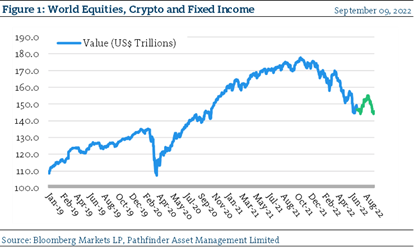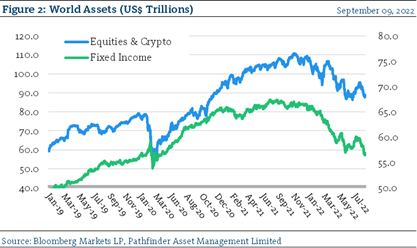Global Market Cap, our final thoughts
We present our final issue of the aggregate market value series where we explore the change in financial assets across time and geographic regions. As a reminder, we had previously compiled various US and International equity, fixed income and crypto data to the end of June and have now updated that to the end of August. We present below total global market values from various indices from FTSE Russell, Bloomberg Markets LP and CoinGeko, that track both aggregate US and non-US equity market value, crypto and fixed income data. We have converted, over time, all of the data to US Dollars so that we have like comparisons. The global data represent US$147.2 trillion in assets as of the end of August 2022.
- In Figure 1, we present an update of the global assets over the summer. The green line is the added data and represents how global market cap changed over the past two months. From the chart, one can see that the drop has been substantial since the peak at the end of last year. Indeed, the value has dropped from US$ 175.4T to US$ 147.8T for a total wealth destruction of US$ 27.6T. This compares to loss during the peak of the COVID collapse of $US $27.9T, just about the same.

- Figure 2 presents the same data above but split into what is traditionally called Risk Assets (equity type) and Non-Risk Assets (fixed income type). As you see during COIVD, after a “wobble” fixed income provided a buffer but during the most recent period, with increasing interest rates, it did not. Fixed income losses since the beginning of the year have been US$ 8.2T versus US$ 5.2T during the worst of COVID.

“This means that” if we view the potential for total loss of wealth in the context of both the Great Financial Recession (GFR) and the market volatility around the shutdowns from COVID, a further potential loss of equity market cap value is still a real possibility. If we hold the value fixed income the same (no guarantee of this given rising interest rates) then for comparison to the GFR, equities could drop a further 15% from here and we would arrive at a similar loss of total wealth. If we experience that kind of drop, and inflation and interest rates continue to climb, then the total wealth destruction would eclipse that of the GFR. We continue to remain laser focused on this in the context of our mandates.
National Instrument 31-103 requires registered firms to disclose information that a reasonable investor would expect to know, including any material conflicts with the firm or its representatives. Doug Johnson and/or Pathfinder Asset Management Limited are an insider of companies periodically mentioned in this report. Please visit www.paml.ca for full disclosures.
*All returns are time weighted and net of investment management fees. Returns from the Pathfinder Partners’ Fund and Partners’ Real Return Plus Fund are presented based on the masters series of each fund. The Pathfinder Core: Equity Portfolio and The Pathfinder Core: High Income Portfolio are live accounts. These are actual accounts owned by the Pathfinder Chairman (Equity) and client (High Income) which contain no legacy positions, cash flows or other Pathfinder investment mandates or products. Monthly inception dates for each fund and portfolio are as follows: Pathfinder Core: Equity Portfolio (January 2011), Pathfinder Core: High Income Portfolio (October 2012) Partners’ Fund (April 2011), Partners’ Real Return Plus Fund (April, 2013), and Partners’ Core Plus Fund (November 2014).
Pathfinder Asset Management Limited (PAML) and its affiliates may collectively beneficially own in excess of 10% of one or more classes of the issued and outstanding equity securities mentioned in this newsletter. This publication is intended only to convey information. It is not to be construed as an investment guide or as an offer or solicitation of an offer to buy or sell any of the securities mentioned in it. The author has taken all usual and reasonable precautions to determine that the information contained in this publication has been obtained from sources believed to be reliable and that the procedures used to summarize and analyze such information are based on approved practices and principles in the investment industry. However, the market forces underlying investment value are subject to sudden and dramatic changes and data availability varies from one moment to the next. Consequently, neither the author nor PAML can make any warranty as to the accuracy or completeness of information, analysis or views contained in this publication or their usefulness or suitability in any particular circumstance. You should not undertake any investment or portfolio assessment or other transaction on the basis of this publication, but should first consult your portfolio manager, who can assess all relevant particulars of any proposed investment or transaction. PAML and the author accept no liability of any kind whatsoever or any damages or losses incurred by you as a result of reliance upon or use of this publication.